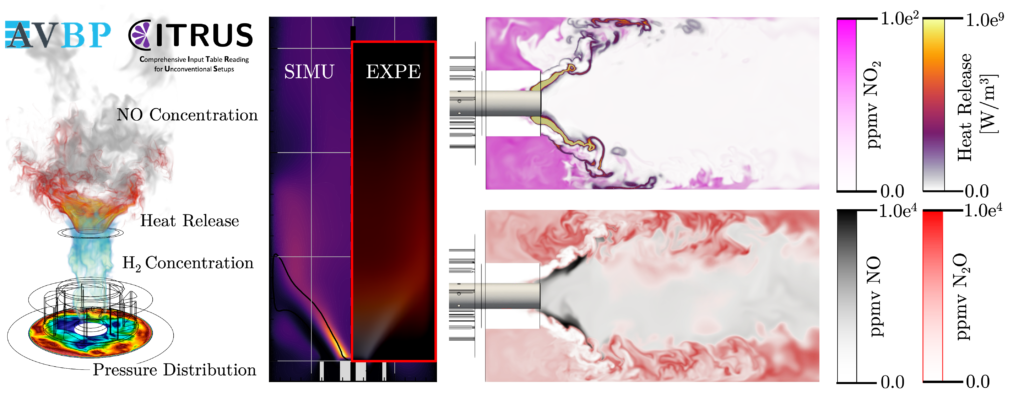🎓Hector VARGAS Thesis Defense
Wednesday 24 September 2025 at 14h00
Phd Thesis Salle JCA, Cerfacs, Toulouse
High-Performance Large Eddy Simulations for the Decarbonization of Industrial Gas Turbine using H2-NH3 Mixtures
MEGEP (Mécanique, Energétique, Génie civil & Procédés)
https://youtube.com/live/b0KV1yZkeak?feature=share

The urgent need to address climate change has placed unprecedented pressure on the energy sector to reduce greenhouse gas emissions. While renewable energy sources like wind and solar power are leading the transition to sustainable energy production, certain applications, particularly in heavy industry and transportation, require the high power density and reliability that only gas turbines can provide. In this context, carbon-free fuels such as ammonia or hydrogen present a promising alternative to conventional fossil fuels, offering, in some cases, established storage and transport infrastructure while eliminating carbon emissions. The decarbonization of energy production through carbon free fuels requires fundamental understanding of both chemical kinetics and turbulent combustion modeling. This dissertation investigates ammonia-hydrogen combustion for industrial gas turbines, addressing these challenges sequentially to develop reliable numerical tools for practical applications. First, a review of ammonia-hydrogen chemical kinetics mechanisms was conducted, comparing their performance against experimental data at gas turbine relevant conditions. This led to the development of two novel Analytically Reduced Chemistry (ARC) mechanisms using the ARCANE reduction code. The second phase addressed the challenges of turbulent combustion modeling in partially premixed, multi-fuel injection systems. The standard Thickened Flame (TFLES) approach was extended to handle fuel composition heterogeneities, resulting in the Multi-Fuel TFLES (MF-TFLES) model which was implemented in the massively parallel LES code AVBP. The Cardiff University’s stratified burner served as an experimental test case, combining upstream ammonia-air premixed injection with downstream hydrogen injection. The flame structure and pollutant distribution were characterized through OH*, NH*, and NH2* chemiluminescence imaging and NO-PLIF measurements. Finally, Large Eddy Simulations (LES) employing the developed ARC mechanism and MF-TFLES model were used to investigate NO chemical formation pathways. The study identified several production mechanisms across different flame regions, correlating them with local mixture composition, temperature fields, and flow structures. Results showed the significant influence of local hydrogen enrichment in lean conditions. The developed numerical framework, combining detailed chemical kinetics, turbulent combustion modeling, and pollutant formation analysis, provides insights for the development of low-emission ammonia-hydrogen-based combustion systems through validated numerical predictions. By leveraging High Performance Computing (HPC) and high-fidelity LES, this work contributes to the developing innovative combustion technologies, thus supporting the critical transition toward a decarbonized future.
Jury
| M. Christian HASSE | Technische Universität Darmstadt (TU Darmstadt) | Referee |
| M. Alessandro PARENTE | Université Libre de Bruxelles (ULB) | Referee |
| Mme Christine MOUNAÏM-ROUSSELLE | Université d’Orléans | Examiner |
| M. Thibault GUIBERTI | King Abdullah University of Science and Technology (KAUST) | Examiner |
| M. Laurent GICQUEL | CERFACS | Advisor |
| M. Davide LAERA | Politecnico di Bari (POLIBA) | Co-Advisor |
| M. Ghislain LARTIGUE | CORIA | Co-Advisor |
No content defined in the sidebar.

